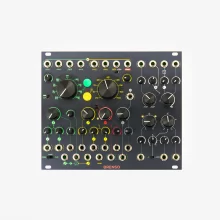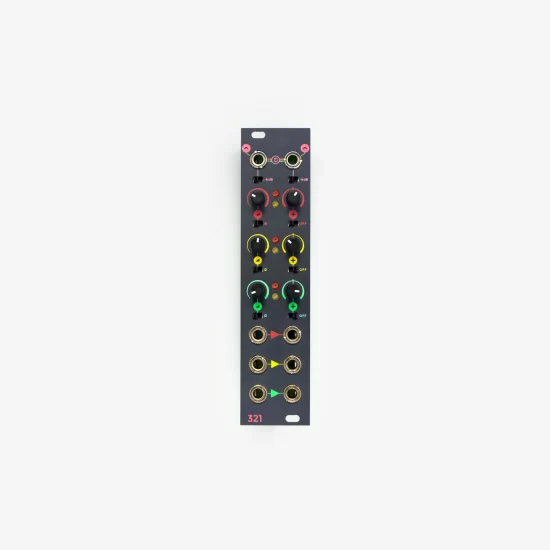Brenso
BRENSO
Entangled Sound Sources
brenso /ˈbreːnso/ adj. [slang portmanteau word created from the Italian adjectives breve ‘short’ and intenso ‘intense,’ probably around the early 2000s in the area of Bologna; pronounced with the long, closed e instead of the expected open ɛ, as typical of the Northern Italian regions] — This adjective may have originally referred to events or experiences that were particularly powerful despite their short duration. Soon its meaning broadened, indicating anything (objects or even thoughts) that feature great content in proportion to the size. For example, nowadays, a thick lasagna or a massive live performance can be equally ‘brense.’
OR:
550,00 € + VAT
In stock
Description
BRENSO is Frap Tools’ primary analog source of articulated waveforms whose degree of entanglement can be precisely set by the musician.
Its concept developed from a reflection on the very meaning of the word ‘complex,’ which comes from the Latin verb plector, literally meaning ‘to weave.’ The purpose of BRENSO is to update the usual approach to complex oscillators by offering many threads to be woven together, rather than a pre-defined weft of controls and waveforms: this to improve clarity, manageability, and provide more sonic options to the artist.
BRENSO consists of three sections: two for sound generation (yellow and green), and one for sound processing (white and red).
The generation sections allow control over the two triangle-core oscillators, which can be modulated and synced both internally and externally. The Frequency Modulation can be any combination of exponential and/or linear through-zero.
The processing section is composed of a Timbre Modulation section (white) and a final stage of Amplitude Modulation (red). The Timbre Modulation contains two parallel waveshapers with a PWM circuit, which are mixed with a crossfader and processed by a wavefolder. The wavefolder has symmetry control and can be pinged through a dedicated clock input with a shapeable, nonlinear behavior.
A four-quadrant multiplier further modulates the timbre-modulated sound with the green oscillator’s sine wave: it can perform amplitude modulation or ring modulation, and a crossfader defines the balance between the modulated and unmodulated signal.
The Timbre section CV inputs are semi-normalled to a Timbre Modulation Bus, which is, in turn, semi-normalled to the green sine wave. Many other modulation destinations are semi-normalled to the other oscillator’s sine wave, with attenuverters and attenuators to guarantee precise control. All the semi-normalizations can be ‘broken’ anywhere throughout the signal routing according to the musician’s needs.
Key Features
BRENSO brings to the surface all the ways of shaping your sound: frequency modulation, amplitude modulation, and timbre controls.
Both oscillators have their independent FM modulation circuit.
The yellow oscillator, then, feeds a Timbre Modulation section which, in turns, can be blended with its amplitude- or ring-modulated copy.
We designed the timbre modulation section from scratch with two wavefolders, a waveshaper, and a PWM circuit.
A dedicated VCA controls the global amount of modulation to each parameter section. The green oscillator is the default modulator, but you can override the semi-normalization anytime.
Many controls allow for complex and detailed FM sound shaping. It is possible to set exponential and linear thru-zero FM independently per each oscillator and control the FM Deviation through two separate knobs or CV inputs.
(The green oscillator can also work at sub-audio rate and can therefore become a super complex LFO!)
No more tuning issues during a performance!
Every oscillator has a button that locks its coarse frequency to the current value. From this moment on, every twist of the ‘Coarse’ knob will be ineffective (but The Fine knob is still available, from small adjustments on the fly!).
BRENSO’s oscillators feature thru-zero triangle cores, which guarantee exceptional tracking and the best response to audio-rate modulation.
You won’t need to find a sweet spot because we designed BRENSO to sound ‘as expected’ in any setting!
The green oscillator has four outputs: sine, triangle, square, and sawtooth.
The yellow one has four outputs: sine and triangle as well, then a selectable square/shaped square output, and a Final output for the triangle wave after its routing through the Timbre and Amplitude Modulation sections.
We designed from scratch an analog circuit that, when excited by an external trig, opens the wavefolder above its maximum level and then closes it down with a non-linear slope, whose length can be manually regulated.
This solution can generate percussive tones with a very organic decay.
You can sync the green oscillator to the yellow one in two ways.
The Lock Sync removes any unwanted beating and preserves tracking.
The Flip Sync reverts the synchronized oscillator’s direction to the rising edge. It is similar to the classic Hard Sync but without forced restarts and sudden “pops” like in sawtooth-core oscillators.
Learn
Learn
Learn
Additional information
| Weight | 0,57 kg |
|---|---|
| Dimensions | 15,6 × 23,6 × 6 cm |
Specs
Size | 30 HP |
Depth | 38 mm |
Current draw | 325 mA @ +12 V 235 mA @ -12 V |
Recommended warmup time | 30 min |
V/oct input impedance | > 90 KΩ |
FM source input impedance | > 30 KΩ |
Deviation CV input impedance | > 90 KΩ |
Integrator CV input impedance | > 40 KΩ |
Sync input impedance | > 60 KΩ |
Sync input minimum amplitude | 2 Vpp |
Sync input suggested amplitude | ±5 Vpp |
AM CV input impedance | > 40 KΩ |
AM source impedance | > 90 KΩ |
AM source suggested amplitude | ±5 Vpp |
Modulation bus source input impedance | > 40 KΩ |
Modulation bus CV input impedance | > 90 KΩ |
Triangle waveshaper CV input impedance | > 60 KΩ |
Pulse waveshaper CV input impedance | > 60 KΩ |
PWM CV input impedance | > 90 KΩ |
Wavefolder Source CV input impedance | > 25 KΩ |
Wavefolder CV input impedance | > 60 KΩ |
Wavefolder Symmetry CV input impedance | > 50 KΩ |
Ping input impedance | > 90 KΩ |
Audio output impedance | > 100 Ω |
Audio output amplitude | ±5 V |
Coarse frequency knob range (audio rate) | 27.5 Hz to 7040 Hz |
Coarse frequency knob range (LFO) | |
LFO ratio | 176:1 |
Oscillator tracking | ±5 ȼ |
Oscillator fine tuning | > 1 st |
Oscillator core crosstalk | -50 dB |
More details on the Manualone.
FAQ
A. Use
Our modules are packed with high-quality components that demand a proper power supply and can get sensibly warm.
That is its normal temperature and we can guarantee their performance.
The timbre section is part of the sound generation and we designed the signal path to derive its waveforms straight from the oscillator’s core, so no, it is not meant to be used with external signals.











